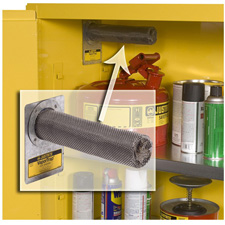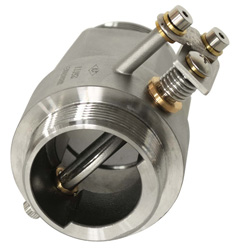| The Home page of ILPI's Safety Data Sheet (SDS) Resource, the leader in SDS information since 1995! | |
| The history and philosophy behind this resource. | |
| A curated collection of books and reference materials concerning Safety Data Sheets and closely related topics. | |
| Paste your plain text SDS into the SDS-Demystifier, and it will be converted into a hypertext-enriched document with links to detailed explanations of each key term. | |
| An extensive list of frequently asked questions about Safety Data Sheets including regulations, content, compliance, and more. | |
| A humorous take on Safety Data Sheet jargon. Fill in the blanks on our entry form to generate a personalized Unsafety Data Sheet to share with your coworkers. | |
| Since 1995, we've maintained this massive curated list of the best places to find Safety Data Sheets on the Internet. | |
| Way more than a glossary, this hypertext-enhanced resource covers hundreds of SDS-related terms and expert knowledge. Each entry includes both the SDS relevance and links to additional authoritative resources. | |
| Archived results of Safety Data Sheet related polls taken by some of our millions of site visitors | |
| You are here! The OSHA regulations behind SDS regulations, including the inspection guidelines and over 400 official interpretations letters under the Hazard Communication Standard | |
| Commercial suppliers of SDS authoring and management software as well as cloud compliance services. | |
| Commercial companies that will create SDS's for your specific needs as well as SDS translation companies. |

Safety signs, banners, and scoreboards? Get yours at Safety Emporium!
| Title: 05/09/2017 - Separate SDSs and labels for dual components | |
| Record Type: Interpretation | Standard Number: 1910.1200, 1910.1200(f)(1), 1910.1200(g)(1), 1910.1200(g)(2) |
OSHA requirements are set by statute, standards and regulations. Our interpretation letters explain these requirements and how they apply to particular circumstances, but they cannot create additional employer obligations. This letter constitutes OSHA's interpretation of the requirements discussed. Note that our enforcement guidance may be affected by changes to OSHA rules. Also, from time to time we update our guidance in response to new information. To keep apprised of such developments, you can consult OSHA's website at https://www.osha.gov.
May 9, 2017
Mr. John P. Lenore
Quaker Chemical Corporation
13210 Barton Circle
Whittier, California 90605
Dear Mr. Lenore:

Keep your workplace safe by using the VaporTrap™ Filter for VOC Vapors from Safety Emporium.
Thank you for your letter to the Occupational Safety and Health Administration (OSHA), Directorate of Enforcement Programs. Your letter requested clarification on labeling under the revised Hazard Communication standard (HCS 2012), 29 CFR 1910.1200. This letter constitutes OSHA 's interpretation only of the requirements herein, and may not be applicable to any questions not delineated within your original correspondence. Your paraphrased question and our response is below.
Background: Your company is in the process of developing a two-component material that would be distributed in a 120 milliliter (mL) pair of tubes containing 60 mL of Part A and 60 mL of Part B, for use by end users. Separate safety data sheets (SDSs) and labels are used in the manufacturing environment and in all situations where Parts A and/or B can be produced, stored, or distributed independently. The two tubes are attached as a dual cartridge that cannot be separated. The dual cartridge is designed to be inserted into a gun-type applicator and the two materials are intended to be squirted simultaneously and mixed through an orifice as it is squeezed onto the surface. The end user is only exposed to the mixture (barring container failure or deliberate misuse) for approximately five minutes until it hardens.
Question: Would it be acceptable to treat the two components as one mixture for the purpose of hazard communication to the end user (SDSs, labels, etc.)?
Response: No. OSHA considers each tube containing Part A and Part B to be separate containers, and therefore, each tube must be individually labeled in accordance with 29 CFR 1910.1200(f)(1). The HCS 2012 requires the manufacturer or importer to ensure that each container of hazardous chemicals leaving the workplace is labeled, tagged, or marked in accordance with 29 CFR 1910.1200(f)(1)(i)-(vi).
Additionally, section 1910.1200(g)(1) requires chemical manufacturers or importers to develop an SDS for each hazardous chemical they produce or import. Because Parts A and B are distinct chemicals in separate containers, an SDS is required for each chemical. Single SDSs are permitted only when components have similar hazards and contents (i.e., the chemical ingredients are essentially the same, but the specific composition varies from mixture to mixture). See 1910.1200, Appendix A.
When a manufacturer or importer intends for a chemical to be used with another chemical (e.g., two chemicals in dual containers will be mixed together, even for a short duration), and that use creates a new hazard, this information must be included on the SDSs for each hazardous chemical in the reaction products in Section 10(c) (Stability and reactivity) of the SDS. OSHA would require information on the safe handling and use of the reaction product in other sections of the SDS such as 4 (First-aid measures), 5 (fire-fighting measures), 6 (accidental release measures), 7 (handling and storage), and 8 (exposure controls/personal protection), if different than the individual components. See 1910.1200(g)(2).

Vent your flammable storage safety cabinets safely with Safe-T-Vent thermally-actuated dampers from Safety Emporium.
As you may be aware, California is one of 26 states plus Puerto Rico and the Virgin Islands that operates its own occupational safety and health program under a plan approved and monitored by federal OSHA. Employers in California must comply with state occupational safety and health requirements. As a condition of plan approval, State Plans are required to adopt and enforce occupational safety and health standards that are at least as effective as those promulgated by federal OSHA. A state 's interpretation of their standards must also be as least as effective as federal OSHA interpretations. If you would like further information regarding California 's occupational safety and health requirements, you may contact California at the following address:
Oakland, CA 94612
Telephone: (510) 286-7000; Fax: (510) 286-7037
Thank you for your interest in occupational safety and health. We hope you find this information helpful. OSHA 's requirements are set by statute, standards, and regulations. Our letters of interpretation do not create new or additional requirements but rather explain these requirements and how they apply to particular circumstances. This letter constitutes OSHA 's interpretation of the requirements discussed. From time to time, letters are affected when the Agency updates a standard, a legal decision impacts a standard, or changes in technology affect the interpretation. To assure that you are using the correct information and guidance, please consult OSHA 's website at http://www.osha.gov. If you have further questions, please feel free to contact the Office of Health Enforcement Programs at (202) 693-2190.
Sincerely,
Thomas Galassi, Director
Directorate of Enforcement Programs
The original official public domain version of this document is available from OSHA at https://www.osha.gov/laws-regs/standardinterpretations/2017-05-09.